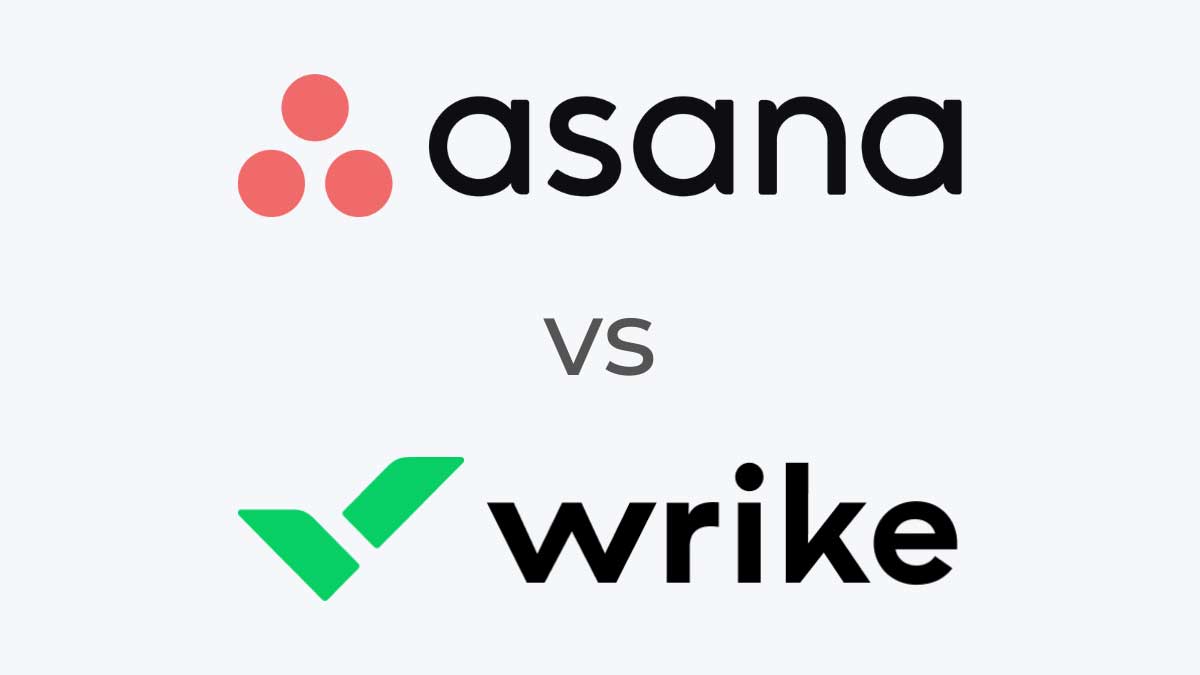In the hunt for the perfect project management software, Asana vs Wrike is a contentious subject among project managers. Some find Asana’s ability to break down complex tasks into bite-size chunks quite handy. Others believe Wrike’s one-stop solution for organizing tasks by project, department, campaign, or preferred criteria is a lifesaver.
The truth is both Asana and Wrike are high-end PM software in the industry, used by top project managers. At a quick glance, they both seem similar but a deeper look into both will reveal that they’re each suitable for specific use cases. In this expert comparison, we’ll explore the strengths of each PM tool to help you determine one that’s right for your project.
A Glance Look at Asana Vs Wrike
Both Asana and Wrike come fully packed with features that can take out the stress in your project management. Before delving deeper into the comparison, it’s worth noting that both excel at managing different types of projects.
If you’re dealing with complex projects involving diverse teams where each task has a subtask owned by different people, Asana is your ideal PM tool. On the other hand, if you run agile or scrum projects with lots of customizations, Wrike will be a useful tool for your scenario.
In general, these two project management tools share some similarities that make them strong players in the market. They both focus on collaboration and offer app integrations and other important project management features.
Now, let’s dig deeper into the Asana vs Wrike comparison to understand how each tool is different.
What is Asana?
Asana is a powerful work management and productivity software built by a San Francisco-based company, Asana, Inc. The tool PM tool was launched in April 2012 and has continuously improved to enhance project management. It’s primarily a work management tool that also incorporates task and project management features.
Asana’s popularity lies in its ability to allow teams to track every aspect of a project, manage resources, and collaborate in real-time. The PM tool is available as a cloud solution accessible over the web, mobile (iOS and Android), and desktop app (Mac and Windows).
What is Wrike

Wrike is a renowned work and project management software built by Citrix. The beta version of te software was first released in December 2006. It then took the company a couple more years to develop and release the Enterprise version in December 2013.
Wrike’s selling point is its customizability, offering almost everything customized to suit project management requirements. It offers custom dashboards and workflows, allowing teams to dictate what they want in their project management. It also offers end-to-end visibility and real-time management of projects. Apart from the web platform, Wrike is available for mobile devices (iOS and Android) and desktops (Mac and Windows).
Asana Vs Wrike – Feature Comparison
To understand how each PM tool operates, we collected information about them from our in-depth hands-on tests. We also gathered information from the websites of the owners and other renowned software review sites to create this Asana vs Wrike expert comparison.
Appearance and User Interface
When it comes to user interface presentation, Asana and Wrike are equally beautiful with easy-to-use and navigate interfaces. You can gain useful insights about the progress of projects at a glance.
Asana has a simple and intuitive design. It adopts a clean layout that team members can navigate quickly to adapt to the project workflow.
Wrike on the other hand, implements a dynamic interface that prioritizes versatility and customization. It empowers users to tailor workspaces and accommodate intricate project structures or unique requirements.
Task management
Both Asana and Wrike follow similar approaches to task management. They allow adding and sorting tasks, setting deadlines, and sorting tasks by their due dates. Both allow teams to break complex tasks into subtasks for easier management.
Also, teams can choose to view tasks using different views. However, Wrike takes the day for its versatile views that include Kanban boards, Gantt charts, tables, Streams, and traditional task lists. It can meet the demands of projects with intricate dependencies and varying styles of work.

On the other hand, Asana excels at straightforward management of tasks by offering various views including calendars, lists, and boards.
The main difference between these two PM tools in managing tasks is in time-tracking. Wrike relies on a built-in tool to track time for tasks. Asana falls short on this as it lacks a time-tracking feature. However, it allows integration with third-party tools, but this too may not perfectly suit your use case.
Team collaboration
Team collaboration is a key aspect of every project. Fortunately, both PM tools are equipped with features that simplify collaboration. Asana and Wrike team members to add task comments, create and share team calendars, and upload attachments. They also offer proofing tools which come in handy to streamline feedback within one platform.
If your team communicates via email, both PM tools support integrations with emailing platforms to facilitate this type of collaboration. However, there are some variances in Asana vs Wrike team collaboration features. For instance, Wrike allows teams to edit the descriptions of tasks at the same time using the live editor. On the other hand, Asana doesn’t provide this.
App integration
Apart from task management and team collaboration, both Asana and Wrike come out strong on supporting integrations. Both tools offer an extensive list of apps that can be integrated to allow file sharing, sales, reporting, and software development requirements. Some of the supported app integrations include Jira, Zoom, Google Drive, Salesforce, Slack, Microsoft Teams, GitHub, and more.
On app integration, Asana offers more than 100 app support to make project management easier. Check out Asana’s list of apps to know whether your preferred app is supported.
The major difference between these two PM tools is that Asana supports integration with many small and midsize businesses (SMB) focused apps. Wrike, on the other hand, supports mainly enterprise app integrations.
Customization

When it comes to customization, you’ll appreciate how both Asana and Wrike excel at it. in both PM tools, you can create custom workflows. Asana comes with a visual tool called Workflow Builder that allows you to automate the workflow creation process. It allows customizing the reporting dashboard with the required specifics to make running the project easier. Asana heavily relies on integrations to meet most of its customization features.
Wrike allows teams to automate workflow creation using its Automation Engine. However, it goes beyond to focus more on customizations and versatility. Teams can customize their workspaces to accommodate specific organization requirements and complex project structures.
Summary of Asana vs Wrike Feature Comparison
| Feature | Asana | Wrike |
| User Interface | Clean and intuitive design | Dynamic interface with customization options |
| Task Management | Kanban boards, lists, calendars | Gantt charts, Kanban boards, task lists |
| Collaboration Features | Task comments, attachments, mentions | Task mentions, file attachments, feedback |
| Integration Capabilities | Broad range of integrations | Extensive integrations, Zapier support |
| Customization | Custom fields, project templates | Customizable dashboards, task fields |
| Automation | Rule-based automation | Advanced automation capabilities |
| Calendar and Timeline Views | Calendar and timeline views | Gantt chart for timeline visualization |
| Reporting and Analytics | Basic reporting features | Advanced reporting, analytics dashboard |
| Mobile Accessibility | iOS and Android apps | iOS and Android apps. |
| Project Templates | Available for quick project setup | Templates for various project types |
| User Permissions | Customizable user roles | Granular control over user permissions |
| File Attachment Options | Attach files directly to tasks | Supports file attachments and proofing |
| Workspaces and Teams | Workspaces and teams for organization | Flexible workspace and team structures |
Asana Vs Wrike: Pricing Comparison
When it comes to Asana Vs Wrike pricing comparison, both tools offer a free plan and a tier-based plan. Asana’s tiered pricing changes according to the number of users and the selected features. Wrike also has a tiered pricing structure but the plans change depending on the number of users and functionality level chosen.
Both provide unlimited collaborations with third parties as guests in Asana and collaborators in Wrike. That means your team can interact with external vendors, clients, freelancers, and contractors by accessing all free features.
The free plan on Asana is available for 10 users and comes with limited access to premium features. If you upgrade to the Starter plan, the features increase and you’ll have to pay $10.99 per month per user, up to 500 users. Under the Advanced pricing plan, you’ll be charged $24.99 per user per month for up to 500 users. The plan will include everything under the Starter plan plus many more, such as 25,000 Automations per month.
Wrike’s free plan is a bit limited in features, but available for an unlimited number of users. That means if you want more features for use with a team of three up to 25 people, you need to upgrade to their Team plan. The Team plan costs $9.8 per user per month. The Business plan is available for up to 200 users at a cost of $24.8 per user per month. If you have a bigger team, then you’ll have to contact Wrike to see if the Enterprise or Pinnacle plans can suit your needs.
On pricing, Wrike seems to lack transparency on its top-tier pricing plans. Despite offering an unlimited number of users under the free plan, the available features are limited and you’ll be forced to upgrade.
Asana vs Wrike: The Verdict
In this Asana vs Wrike comparison, you’ll notice that both PM tools are solid with unique strengths. Asana takes the day when it comes to simplicity and straightforward task management. Wrike has advanced capabilities that make it ideal for diverse team structures and complex projects.
Wrike best suits the needs of medium to large teams with a higher level of project management needs. It can overwhelm smaller businesses that don’t have complex project requirements. Asana doesn’t offer as many features as Wrike, but its functionality is enough to suit most teams. It’s therefore ideal for smaller teams with less complex project requirements. If you find Wrike a bit overwhelming for your project requirements, Asana offers a superb alternative.
Fortunately, both PM tools offer free plans that you can use to sample each to determine its suitability for your project and teams.

